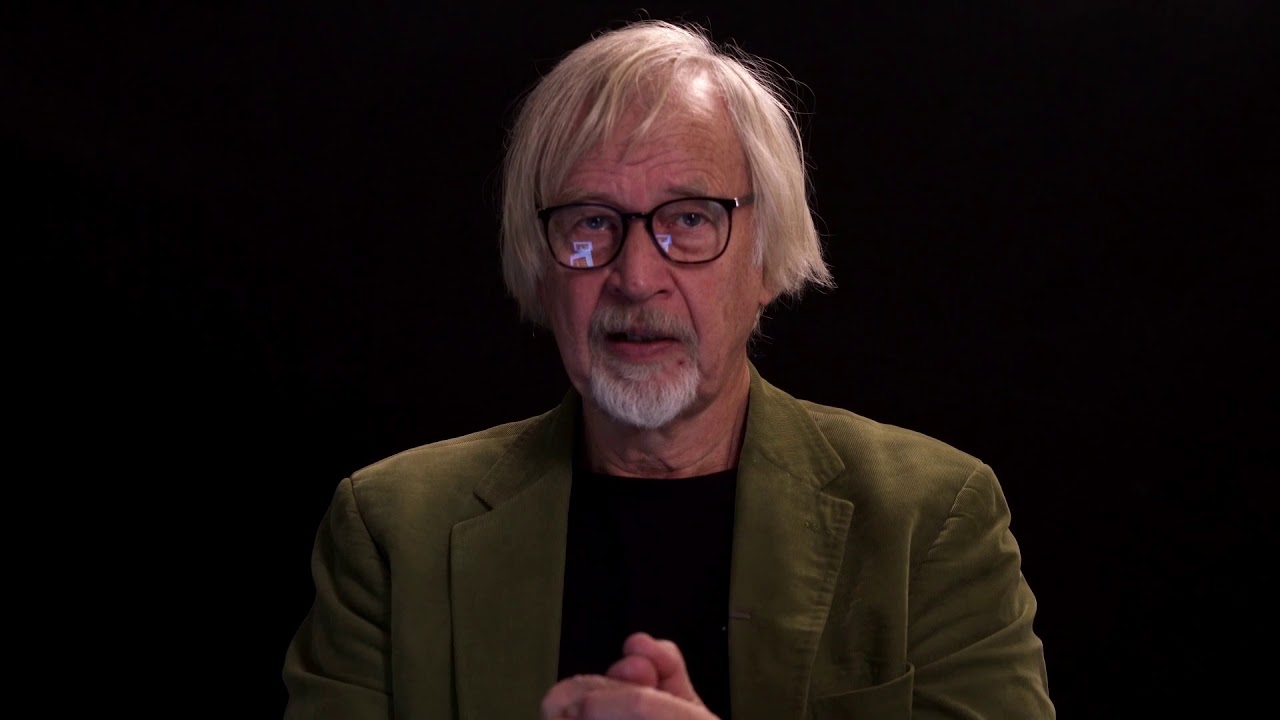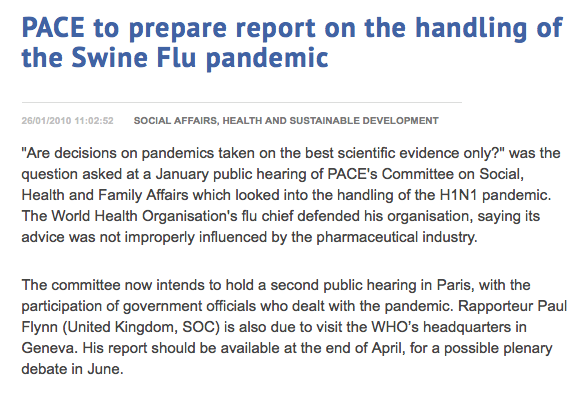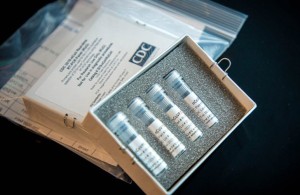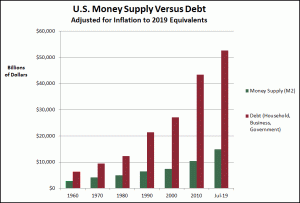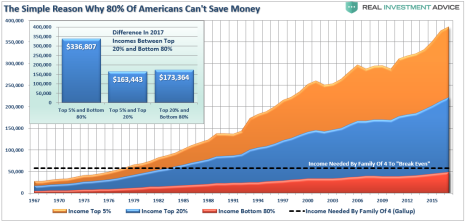“It is easier to rob by setting up a bank than by holding up a bank clerk.” – Bertolt Brecht
Daily, a thus distracted public is told that the financial patsy for the growing worldwide economic disaster is simply a virus. As Americans fearfully watch passively as the US Congress throws the ever-mounting trillions in Bail-out funds so quickly at the feet of their puppet masters, the paltry cash reserves of all American bank depositors have never been more at risk.
“I’m sorry, Sir. We are unable to cash this check,” were the rather ominous words delivered to me by a fresh-faced, none-too-friendly, Wells Fargo Bank assistant manager. He had just kept me waiting ten minutes while in consultation with others about my pending transaction. Returning to his Wells’ colored cubicle he sat down quickly, straightened in his chair and then looked at me intently through narrowed eyes before delivering the bad news.
Four feet away, between us and in front of him, were three forms of my personal identification face up. Looking down, this budding banker particularly glowered at two personal checks, also laying on the desk before him, written to me as payment by a client and drawn on his bank. Not being a “Wells” customer I had expected a shake-down, hence I had brought with me multiple forms of ID including passport.
These two checks totalled the small sum of almost US$8,000.00. Not expecting this much difficulty I insisted on a reason, to which he now looked up from once again carefully considering the two checks and replied, “I’m sorry, but the bank does not have sufficient funds on-hand to cash these checks.”
Oh, dear.
*
For those fortunate Americans who have personal cash savings available and would prefer to keep them, the unspoken reality is: that in 2010 your Congress legalized any bank’s total control over your savings deposits should, by financial urgency, the banks say that they need them.
Ten years ago, in the aftermath of the 2008-9 Great Recession the US Congress, then, approved a 30,000-page bill that you were told would fix, once and for all, the ills of the evil banks and the need for them to ever be “Bailed-Out” again. The 2010 Dodd-Frank Wall Street Reform and Consumer Protection Act in part provided the Federal Deposit Insurance Corporation (FDIC) with new powers and methods to guarantee depositor’s savings. Incredibly, congress failed via Dodd-Frank to regulate the derivatives trade despite this type of fiscal Russian roulette applied to worthless mortgage-backed securities being the root cause of the original 2008 recession for which everyone-except Wall St. – suffered dearly.
The resultant lack of regulation has seen OTC derivatives increase to$640 trillion at end-June 2019.
Considering that banks currently reward depositors for this unreported risk with virtually zero- or negative– interest rates, the made-wary depositor would do well to reassess the long-held fallacy that banks have sufficient cash reserves to meet their obligations to a depositor’s cash deposits. Or, that your cash is safe. Neither is true. With the crashing financials of the nation’s largest banks flash in crimson red, your cash has never been more at risk.
Naturally, like the majority of incorrectly informed US bank depositors, I had assumed that this here bank, today, would have lots and lots of cash on hand.
Au contraire.
Unapologetically the Wells manager informed me that he was “sorry” but he could only cash one of the checks at this time. Both checks were for about the same amount. I inquired if this was new bank policy and was told that the bank simply did not have enough cash on hand, and, “no,” I could not come back at the end of the day after the bank had received the day’s cash deposits. However, he informed me that, if I ventured to a larger Wells Fargo branch they might be able to handle both checks at once.
This rather unique news seemed worthy of delving into further, so I declined his kind offer and left with both my onerous financial instruments in hand. Being away on business, I decided to wait and stop by my home town’s main Wells Fargo branch office and investigate this further.
Thus began my quest to pick-up a paltry eight large in cold, hard cash.
Turned out, since Dodd-Frank, I no longer had a primary right to my hard-earned deposited cash, anyway. Nor, even, a secondary right. In fact, when it came to my cash, I, as the bank’s cash depositor, and my money was these days legally a tertiary banking financial obligation at best.
Oh, dear!
*
“… people of the nation do not understand our banking and monetary system, for if they did, I believe there would be a revolution before tomorrow morning.” –Henry Ford
The banks have known this new economic crash was coming for years. Post-2009, US banks also knew well that most American people, thanks to the omissions and distortions by media mythologists, are still woefully ignorant regarding the nuances of the genius of their bank’s financial alchemy that magically creates money out of thin air. Most live daily in the illusion that their financial institutions will protect their deposited savings. This is because they missed their bank’s greedy preparations for the next stock market crash to come.
In the aftermath of 2009, a year later the banks understood that Americans, Europeans and UK citizens had lost all enthusiasm for any future government Bail-Out, most people preferring instead that any institution suffering self-inflicted financial distress should –next time– enjoy the fruits of their crimes via formal bankruptcy proceedings.
After the Obama era Troubled Asset Relief Program (TARP) chucked its own $trillions into the 2009 trough back then, the “Too Big to Fail,” (TBTF) banks developed a very fraudulent and elitist connotation as did the applicable term, “Bail-Out.” To millions across the world who had lost their homes, pension funds, retirement plans- and dreams– these were both now very tired monikers for financial oppression and fraud. In 2010, the previously bailed-out TBTF banks were provided with a far more magnificent definition: “Globally Active, Systemically Important, Financial Institutions” (G-SIFI).
As for the much-maligned and properly vilified “Bail-Out”? No… No. That, too, recalled those days of congressionally imposed privation. Would not a “Bail-In” sound much more welcoming? More acceptable? “Bail-Outs,” may have lost their popular flavour but in the new world of the G-SIFI, the next bank bail-out is actually just a “Bail-In,” away.
Yes, Bail-Ins are now the new “systemically” correct term for publicly guaranteed banking fraud. With the Bail-out thus discredited, this new politically correct renaming has now been incorporated in newly crafted national policies and laws appearing in multiple other countries as well. These finance laws, such as Dodd-Frank and its similar UK and European Union versions, turn the intent of Dodd-Frank on its head and make future Bail-Ins legal. The difference in the definition should shock any bank depositor.
These Bail-Ins allow failing G-SIFI banks, should they need to avoid insolvency, to legally convert the cash funds of “unsecured creditors” (the bank’s depositors) into bank capital. This also includes “secured” creditors, like state and local government funds. Like pensions.
The 2008-9 reaction to the financial damage of the recession was a massive effort to avoid that systemic financial bankruptcy. The increased and unregulated use of derivatives was a primary cause of the fiscal damage then. In the aftermath, rather than regulation, thanks to Dodd-Frank, derivatives suddenly were amazingly provided “super-priority” status in any future bank bankruptcy.
Worse, at the same stroke of Obama’s pen, formerly secure cash depositors were suddenly demoted to “un-secured” status.
As America once again impotently watches a new orgy of massive “Bail-Outs” being thrown just as quickly at Wall Street as during 2008-9, one might also recall how their corporately controlled Federal Reserve Bank and US Congress threw, then, several trillions of US taxpayer dollars just as quickly at US corporations and banks. Massive public funding under TARP also went then to any corporation with enough political pull to be defined as “Too Big To Fail” (TBTF). These were the Bail-outs of yore.
The financial law firm Davis Polk estimates the final length of Dodd-Frank, the single longest bill ever passed by the US government, is over 30,000 pages. Before passage, the six largest banks in the US spent $29.4 million lobbying Congress in 2010 and flooded Capitol Hill with about 3,000 lobbyists prior to Obama predictably signing its final unreadversion. Reportedly, no US congressperson, senator, or staffer had bothered to read it.
However, the bank’s congressional minions were told to vote for it. And dutifully they did.
But, the authors of Dodd-Frank did little about derivatives. Banks almost exclusively hold this risk exposure. Today, that estimate is pushing three-quarters of a quadrillion dollars. What this means today for cash depositors is that applied to Dodd-Frank and these same again failing banks, all these upcoming bad bank bets will be paid-off first-not last- using the savings of depositors who are now legally last on the minds of the banks.
Normally in any managed court-ordered capital liquidation via corporate bankruptcy proceedings, secured creditors- such as a bank’s depositors- are paid off first because theirs were hard assets when first deposited, not investments. In the past, secured creditors normally had a mandated and legal priority during any liquidation. However, under the new “Bail-In” of the Dodd-Frank mandates, your government has re-prioritized your bank’s exposure and your cash deposit. Derivatives and other similar banking high-risk ventures are now more highly protected than any bank depositor’s savings which are now treated as un-secured instead.
Similarly, in the 2013 example of Cyprus, Germany and the ECB also made depositors inferior to other bank holdings and investments leaving depositors with, after many months, a small remaining fraction of their deposits.
And then came Greece.
“It’s [FDIC] already indicated that they will confiscate [savings] funds…”. -US congressman Ron Paul
With this recent history in mind, I entered my town’s main branch of Wells Fargo. The two checks in hand. On the way in I was greeted warmly, one after the other, by three more fresh-faced and eager proteges, all smartly uniformed to match the Wells décor, and who proffered in turn, “Good morning, Sir!,” again, and again… and again. Certainly, these little fish were not in possession of authority sufficient to cash my two mammoth checks, so I asked for bigger game: the Branch Manager.
Thus, I explained my plight to a very lovely lass who predicted she, “would be glad to help me.”
“Cheryl,” patiently explained that I had come to the right place and she would be glad to cash both checks. Regarding my previous polite banking experience, she admitted that it was indeed bank policy to have limits on the availability of cash for withdrawals and that different branches had different limits. This was the main branch so my request here was meritorious. Further, she admitted that whatever daily cash coming into the branches in the form of deposits was not available for withdrawal, but was sent from the branch for daily accounting at a central point common to all area Wells bank branches. Only a prescribed amount of cash was provided to each bank for daily customer cash withdrawals. The amount was kept at par to begin each day.
“A couple of times your current request,” was Cheryl’s cautious response to my question about her branch’s limits on check cashing. Not to be put-off, I asked about a hypothetical US$25,000 check. She admitted this would be beyond her branches authority. “But,” she smiled, “Today, you’ve come to the right place.”
We are told that the near-certain global economic collapse was caused most decidedly by a pernicious virus branded as COVID-19. True, but that virus would much better titled, “Unregulated Capitalism.” This week, depositors were repeatedly told by media whores that the banks are safe and not to withdraw cash. This lie was obviously reverse psychology since the lines for ATMs were long and many ran out of cash within hours. CNBC and others assured worried savers that banks will not be given taxpayer bailouts next time. True.
The preamble to the Dodd-Frank Act claims, “…to protect the American taxpayer by ending bailouts.”
But then, how does a failing bank get a Bail-In as a designated G-SIFI without receiving another taxpayer Bail-Out?
No problem. Enter the FDIC and another new banking term, “cross-border bank resolution.”
As the US agency required to pay back depositors who lose savings up to $250,000, FDIC is insufficiently armed with a paltry US$25 billion war chest. Under Dodd-Frank, the FDIC is the mechanism to replace deposits lost or squandered by banking largesse. Sadly for the public, the bank’s US depositors have claims to an estimated US$7.36 trillion in cash. Once the banks steal your savings to pay-off their superior obligations, the FDIC will be more than a tad short of the funds needed. How to fix this mathematical shortfall?
On December 10, 2012, a joint strategy paper was drafted by the Bank of England (BOE) in conjunction with the Federal Deposit Insurance Corporation (FDIC) titled, “Resolving Globally Active, Systemically Important, Financial Institutions.” Here the plot to steal depositor’s savings is laid out.
The report’s “Executive Summary” states,
“… the authorities in the United States (US) and the United Kingdom (UK) have been working together to develop resolution strategies…These strategies have been designed to enable [financial institutions] to be resolved without threatening financial stability and without putting public funds at risk.”
Sounds good until you read the fine print.
Despite the movement of the Congress to rescind the provision, Title II of Dodd-Frank gives the FDIC a new enforcement arm, the Orderly Liquidation Authority (OLA) which is similar to its British counterpart the Prudent Regulation Authority (PRA). Both now have the authority to punish the depositors of failing banking institutions by arbitrarily making their savings deposits subordinate- actually tertiary- to bank claims for the replacement value their derivatives, junk mortgage exposure, and propagation of economic sector bubbles of historic proportions.
Further, with US banks holding $7 trillion in personal cash savings deposits compared to approx. $230 trillion in US derivative obligations, the FDIC’s $25 billion will still not be quite enough. The creators of Dodd-Frank knew this before it was signed. As John Butler points out in an April 4, 2012 review in Financial Sense,
“Do you see the sleight-of-hand at work here? Under the guise of protecting taxpayers, depositors… are to be arbitrary, subordinated… when in fact they are legally senior to those claims…”
Oh, but bank depositors can rest easy in the knowledge that replacing their savings via FDIC will not come out of their yearly taxes via a Bail-Out. Thanks to Dodd-Frank, the first line of defence for depositors will allow Congress to instead replace personal savings via the FDIC with a government paid for $7 trillion bail-in…of your cash savings.
But, what’s another $7 trillion after $6 Trillion last month on top of $23Trillion in accrued national debt after yet another $1trillion yearly US budget deficit?
Fiscal insanity.
Worse than this monetary conjuring act, Dodd-Frank gives new powers to the FDIC and its OLA that allows for an even more powerful and draconian resolution: any deposited funds in a bank, from $1 to $250,000 (the FDIC limit), and everything above, can instead be converted to bank stock!
Since this will eliminate their responsibility, FDIC has provisions within Dodd-Frank so that this can be done, via OLA, quite literally overnight.
An FDIC report released in 2012 reads:
“An efficient path for returning the sound operations of the G-SIFI to the private sector would be provided by exchanging or converting a sufficient amount of the unsecured debt from the original creditors [depositors] of the failed company [Bank] into equity [stock].”
Additionally, per an April 24, 2012, IMF report, conversion of bank debt to stock is an essential element of Bail-Ins included in Dodd-Frank.
“The contribution of new capital will come from debt conversion and/or issuance of new equity, with an elimination or significant dilution of the pre-bail in shareholders. …Some measures might be necessary to reduce the risk of a ‘death spiral’ in share prices.”
As was the case post-2009, in order for affected depositors to retrieve the cash value of what was formerly their cash account balance, the stock provided to them in lieu of their cash must next be sold.
When Lehman Brothers failed, unsecured creditors (depositors are now unsecured creditors) eventually got eight cents on the dollar.
This type of conversion of deposits into equity already had another test-run during the bankruptcy reorganization of Bankia and four other Spanish banks in 2013. The conditions of a July 2012 Memorandum of Understanding resulted in over 1 million small depositors becoming stockholders in Bankia when they were ordered to be sold- for their cash and without their permission- “preferences” (preferred stock) in exchange for their missing deposits. Following the conversion to common stock, these preferenceswere originally valued at EU 2.0 per share. Of course this stock in a bankrupt Bankia continued to tumble in value and like Lehman Bros. ended up being further devalued to EU 0.1 after the March restructuring.
Canada has also stated they were planning a similar “Bail-In” program. The Canadian government released a document titled the Economic Action Plan 2013 which says, “the Government proposes to implement a “Bail-In” regime for systemically important banks.”
However, don’t be getting cute by hiding your cash, precious metals, or passport in a US bank safe deposit box. This illusion of financial security is no longer safe either. Dodd-Frank took care of that, too.
Under Dodd-Frank the FDIC, using the auspices of Dept. of Homeland Security (DHS) can legally, without a warrant, enter any bank vault, have the manager secretly open any and/or all safe deposit boxes and inventory, or seize the contents. Further, if a manager is honest enough to inform the depositor of the illegal incursion they are subject to criminal charges and termination from bank employ. Independent reports reveal that at this point all of America’s safe deposit boxes have already been invaded and inventoried for future consideration.
This situation happened in Greece. Depositors who visited their bank to remove their jewellery or precious metals or cash were met at the bank’s door by security, a metal detector and confiscation.
The power of the now remaining G-SIFI banks and FDIC was further evident when, cash finally in hand, I headed to my own evil bank, JP Morgan Chase, right next door to Wells Fargo. The manager confirmed that the cash withdrawal policy at Chase (which was called Great Western before Chase gobbled them up in 2009) was in keeping with that at Wells; very little cash available on demand. I posed a slight untruth and inquired as to what I should do about my upcoming need for $50,000 in hard cash. No, his bank would not do that on demand, but arrangements could be made to have the cash transferred to his bank. That would only take “about two days.”
Of course, I would need to fill out a few forms. For approval.
“Bank failures are caused by depositors who don’t deposit enough money to cover losses due to mismanagement.” – Dan Quayle
With the American public again on the hook-by law– for the anticipated losses of the banks a distressed depositor might think this plot thus complete. Of course, the realities of Dodd-Frank were, so far in this story, the exclusive purview of the Obama administration.
It should be noted that the only voice of economic reason at the White House at the time, former Fed Chairman, Paul Volker, divorced himself very publicly from this renewed banking scandal of novel economic acumen. As head of Obama’s recession inspired, President’s Economic Recovery Advisory Board, Volker ran into the challenge of renewed fiscal insanity for a year, resigning in January of 2011 in disgust. His departure thus coincided with the beginning of the next ten year orgy of financial criminality flaunted by the banks in the faces of the public as the DoJ let them off every time for pennies-on-the-crime.
The advent of the Trump regime went further to gut the supposed intentions of Dodd-Frank. Right away, the new president issued a memorandum that set in motion his plan to scale back the provisions of Dodd-Frank and repeal the Fiduciary Rule. As example, the House approved legislation on Feb. 2, 2017, to erase a number of core financial regulations put in place by the 2010 Dodd-Frank Act, as Republicans moved a step closer to delivering on their promises to eliminate rules that they claim have strangled small businesses and stagnated the economy. Said Trump,
“I have so many people, friends of mine, with nice businesses, they can’t borrow money, because the banks just won’t let them borrow because of the rules and regulations and Dodd-Frank.”
That’s funny on so many levels.
Never mind, at least, that these poor banks are holding derivative exposure grotesquely larger than the total cash deposits of US savers…nor that their ill-gotten riches- such as the UBS, Wells Fargo, Bank of America, RBS multi-billion dollar criminal prosecutions – were taken off-calendar in Federal court for approx. 15% of the total crime every time. The banks kept the rest. That’s banking.
Banks are worried, but have one big problem: They are still very profitable. So far.
Last week, JPMorgan reported Q1 adjusted revenue of $29.07 billion plunging from a year ago, with dividends down 70% to $0.78 per share. Despite their strong profitability, Wells, Citi and BofA all posted similar declines. However, in reaction to the looming disaster the Big 7 US banks this week set aside some $27 billion in credit loss provisions, a number which is 4x greater than the total provisions set aside a year ago, and the most since the financial crisis. Beyond derivatives, bank’s are already bracing for a surge in defaults and delinquencies on its loans amid the complete US economic shutdown.
On the derivatives front Capital One, the nation’s #11 bank by assets, is already in deep trouble on their derivative exposures. Reportedly, Capital One made highly speculative trades, betting via derivatives that oil would not plunge to where it is now at 17-year lows. With the recession just getting started the price of oil isn’t going anywhere. But Capital One likely is: Bankruptcy
German Deutsche Bank has for years been the face of worldwide banking fraud and risk personified and the working model for US banks. The German bank is again, thanks to derivative exposure, in really deep trouble this time. As Alasdair Macleod writes in an excellent article this week,
“…Deutsche provides us with a laboratory experiment for how a derivative virus can kill a bank.”The looming derivative crisis
Macleod uses Deutsche as the working model for the derivative disaster heading directly at the US and other world banks and their trickery in hiding this massive risk on their books. Using Deutsche Bank’s own accounting Macleod assesses:
“It [Deutsche] conceals derivative exposure under the headings “Trading assets” and “Trading liabilities” on the balance sheet. You have to… discover that under Trading assets… and under Trading liabilities, [there is] a difference of €1.062bn. This is relatively trivial. But wait, there is another table that breaks derivative exposure down even further into categories… The true total of OTC derivatives and exchange-traded derivatives to which the bank is exposed is €37.121 trillion. That is nearly thirty-five thousand times the €1.062bn netted difference in the balance sheet.”
The same equation of GAAP accounting fraud thus hiding a bank’s massive total derivatives risk is being used by all of America’s Big 7 banks right now. And, apparently, Capital One.
The non-banks, US financial institutions and corporations of any and all brands, have this past month shouldered-up together to the congressional piggy bank for a historic $6trillion give away. For any collapsing multinational already running out of tricks to game their stock price with phoney earnings statements, the rush to a global pan-panic could not have come at a better time.
Predictably, the media addled American public-the true Covidiots-have nicely ignored this massive scam in lieu of a, so far, mythical $1200 carrot. Wall Street got theirs, post haste, as congress quickly huddled close together… and America shuddered in lockdown.
Of course, at this point in American economic history the subject of cash to any dollar, Euro, or UK pound sterling only matters, by example, to 40% of the US public because reportedly 60% of American families have less than a grand total of $500 in savings in total. 23 million of them just entered unemployment in the past four weeks as well.
The 2020 stock market fire sparked to life upon a pyre of 2019 economic metrics already sufficient to burn the US national economy to a crisp like a wheelbarrow full of Reichsmarks. This was predicted yearly since 2014 by the champion of laissez-faire banking, JP Morgan/ Chase itself.
Unless one believes in a sudden dramatic resurgence of the US economy in the face of absolutely biblical economic metrics to the contrary- or that Keynesian economic witchcraft will actually prevail- a wise cash depositor might, at this juncture consider the actual safety of one’s life’s savings. The language of Dodd-Frank is the language of banking theft…personified.
*
As shown, daily the banking sector is in far worse shape than before 2010 and, just like the scores of other greedy corporations, banks will also need a Bail-out to avoid catastrophe.
But, since Dodd-Frank passed, the banking sector is restricted from receiving any federal Bail-outs this time? And, banks can legally only get a Bail-in? But, a Bail-in means that my savings deposits… will… be …?
Oh, dear!
With all this in mind, I stepped into the bright sunshine outside of the dim confines of Chase, having apparently cleaned out Wells Fargo of their cash just minutes before. Safely in my coat pocket rested all but $100.00 of my day’s take tucked deep down- and securely; Its final outcome, no one’s god damn business but my own.
So… if you’ve got cash, maybe you ought to get a hold of it soon. Or, when YOUR bank fails, don’t walk…. Run!
YOU do not want to be second in line.
Oh, dear!
*
Note to readers: please click the share buttons above or below. Forward this article to your email lists. Crosspost on your blog site, internet forums. etc.
Brett Redmayne-Titley has published over 180 in-depth articles over the past ten years for news agencies worldwide. Many have been translated and republished. On-scene reporting from important current events has led to his many multi-part exposes on such topics as the Trans-Pacific Partnership negotiations, NATO summit, Keystone XL Pipeline, Porter Ranch Methane blow-out, Hizbullah in Lebanon, Erdogan’s Turkey and many more. He can be reached at: live-on-scene ((at)) gmx.com. Prior articles can be viewed at his archive: www.watchingromeburn.uk
Featured image is from Wall Street on Parade


